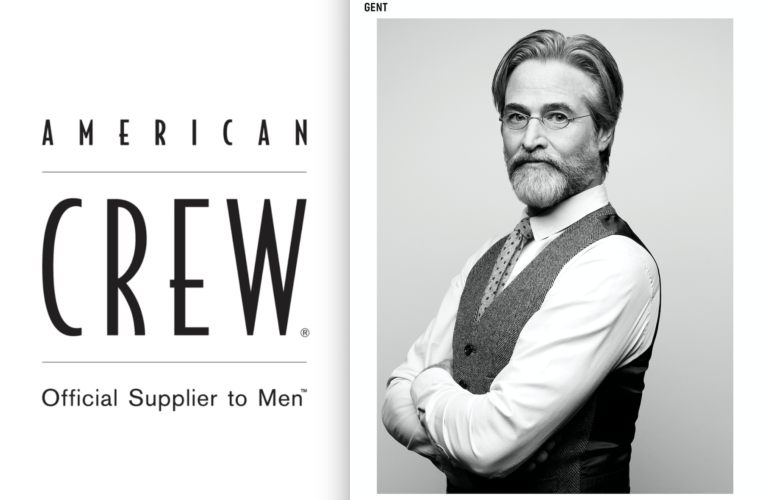David Raccuglia Interview for Canadian Hairdresser Magazine
Q: Tell us how American Crew got started.
I started my career as a barber; I graduated from barber school in 1979. From there, I went on to become a hairdresser. In 1980, I moved to London, England, and began a career as a haircutting teacher and a platform artist for several companies. In 1989, I and several partners opened up a salon in Chicago called Art and Science. I am still a partner in that salon today. I have always loved the craft of barbering. I was very keen on cutting men’s hair, but my cut prices were very expensive. Men at that time were very stubborn about spending money on getting a high-quality haircut. I insisted that a good-quality haircut is of extreme value. It is more important than the shirt or the jacket that you wear. I proved to my clients that a good haircut grows out better, gives you a more attractive appearance and is one of the first things someone notices about your style.
“It was a true game-changer for me. I cut the hair of more than fifty guys: models, friends and colleagues. It was amazing.”
The changing point for me came when I met a photographer named Mark Havriliak. I met Mark in Moscow, Russia, in 1989/1990. I was brought to Russia as a hairdresser to shoot with him. It was a great experience. Mark and I hit off immediately. When we returned to the States, we vowed to work together again. Several months later, it came to me: I wanted to do a book of only men. Mark was on board. We spent the following year shooting together and travelling to New York, Chicago, Los Angeles, London and Minneapolis. It was a true game-changer for me. I cut the hair of more than fifty guys: models, friends and colleagues. It was amazing. That was my first investment in the men’s category. I borrowed the money from a bank and Mark and I self-published Groom in 1991.
Through cutting men’s hair, I realized that classic hair products for men were really needed. I believed that the products used in barbering/men’s grooming had the potential to be as big as any female brands that were on the market. I discussed this with my salon partners and we agreed to invest in this venture. I had a friend and mentor, Frank Gironda, who was a very cool and smart man who helped me raise capital and put together the business structure. We started working on the development of American Crew.
“It was truly the first barbering course of its kind to merge classic precision haircutting and technical training.”
One of the most important assets that we developed was the original barber course that became the foundation of a long-standing cutting curriculum that we still consider today to be one of American Crew’s best assets and offerings. Ha… it was so long ago that it was shot on VHS!! It was truly the first barbering course of its kind to merge classic precision haircutting and technical training.
American Crew was launched 1994 and it has been a quick and exciting 25 years since.
Q: The American Crew campaigns tell stories. Do you collaborate with a marketing team to come up with them? How are these stories conceptualized?
I work with a group of very talented marketers in the American Crew Global Marketing Team. The world has changed a lot in 25 years. We built American Crew the old way, one door at a time. No social media. Barely any internet. It was built through the hard work and dedication of a large group of people whom I am proud to call my colleagues.
Q: You shoot a vast range of subjects, from actors, musicians and public figures to normal people you meet in interesting places. How do you decide on the kind of feel and concept that you will shoot for each of these people? There is such a variety of faces and personalities.
I feel that my photos are all very similar in their sentiment. I love showing subtle gestures and emotions in my photos, maybe a sense of place. I am a pretty simple photographer, not a lot of bells and whistles. Not a lot of “Say ‘Cheese!’” going on.
Q: Do you prefer shooting men’s fashion and beauty over women’s? How do you feel they differ?
I love them both. Because of American Crew I shoot a lot more men, which I do very much enjoy. It’s like a sport for me: creative sparring, a fight, in a good, honourable way. I am much tougher on my male shoots. I want to evoke strength and toughness. Women usually know a lot more than I do, in terms of what works for them. Female models are usually better at flow and movement. I have worked with some amazing male models who do their thing as I just sit back in awe, but, mostly, I dictate the direction of the shoot. I surrender the shoot a lot more to female models.
Q: Your Tibetan photos are works of art. What brought you there and what stood out most to you about that culture?
I love the Tibetan culture. I went there on a photo mission very much inspired by the photos of Edward Curtis, an American photographer and ethnologist who focused his work on Native American culture.
Q: I have a feeling that you are a blues fan. Tell us about the men you chose to shoot. Did they play for you while you photographed them?
I have been blessed with the ability to shoot musicians I love. I do love the blues; however, I have broad taste in music. One of my best memories is of photographing Ray Charles as he played the piano. It was surreal.

